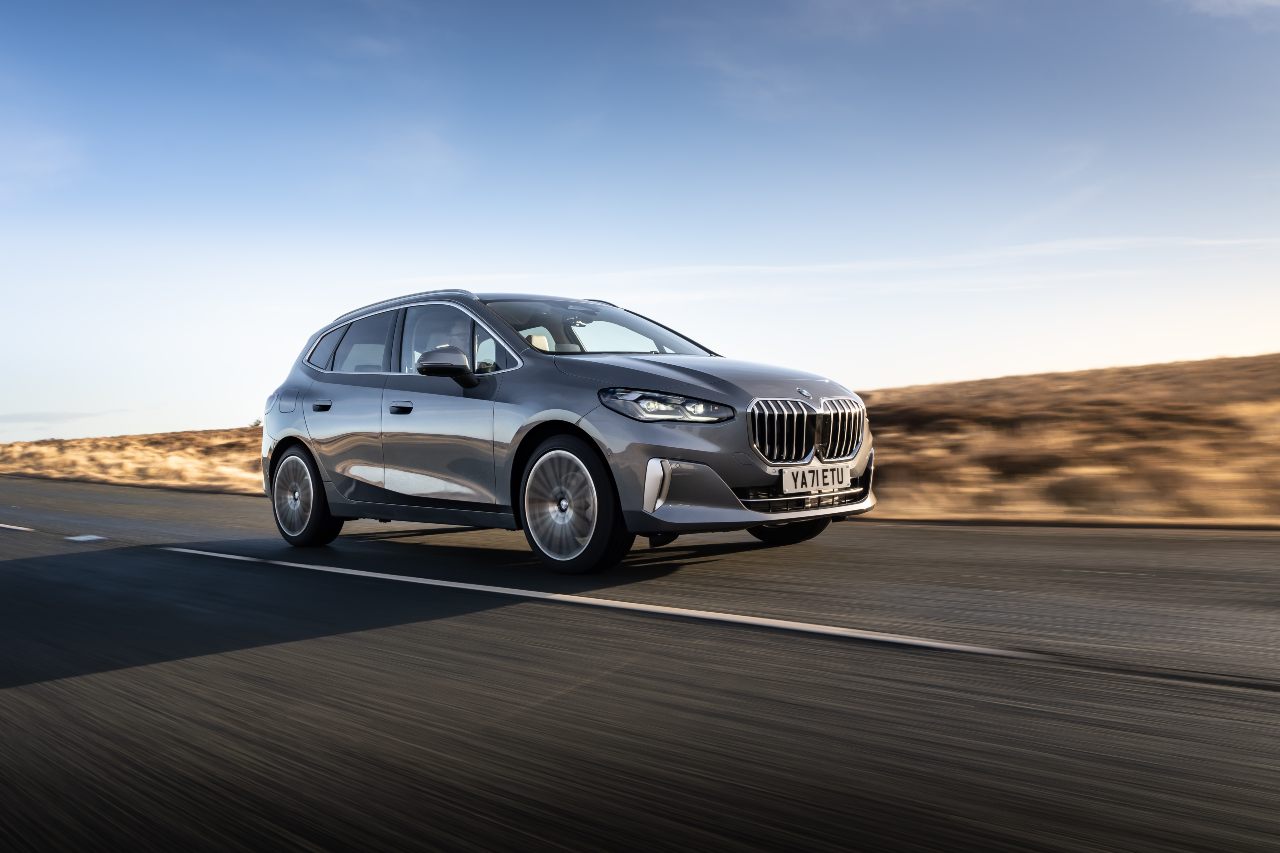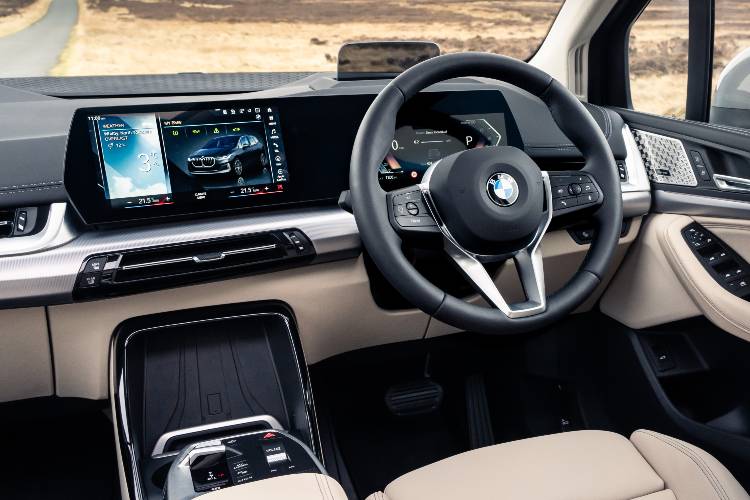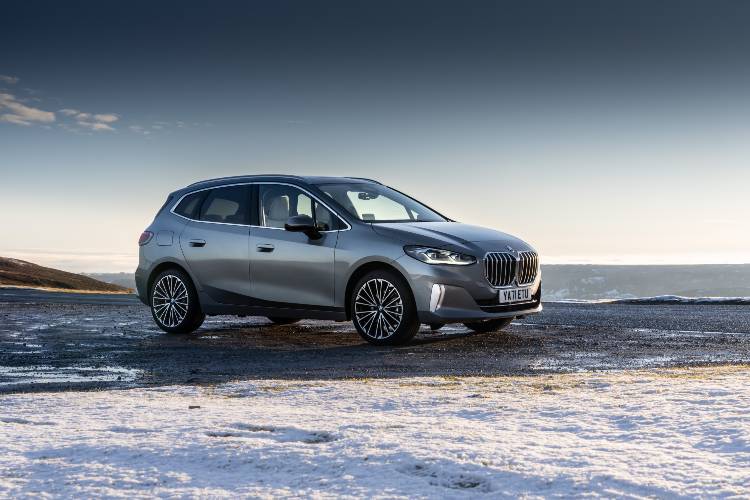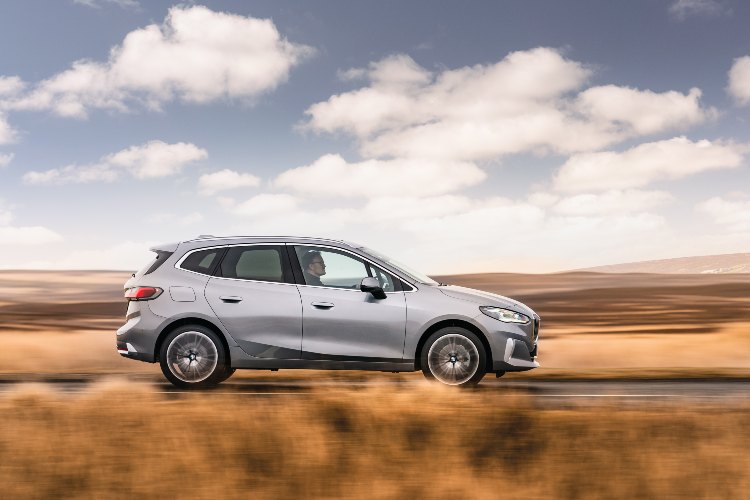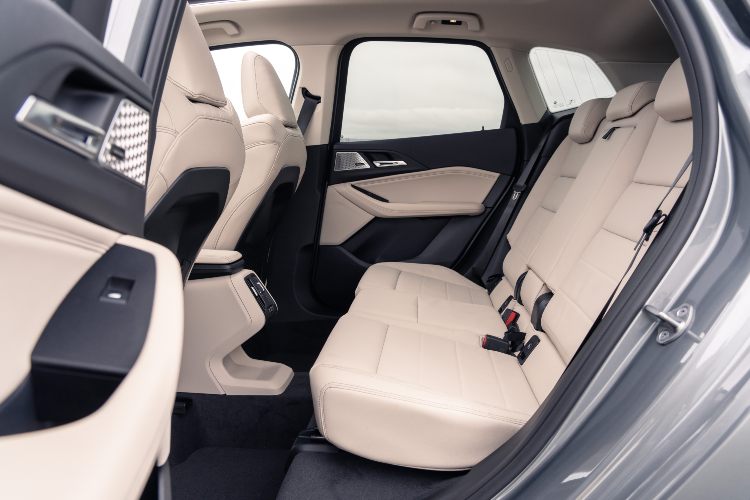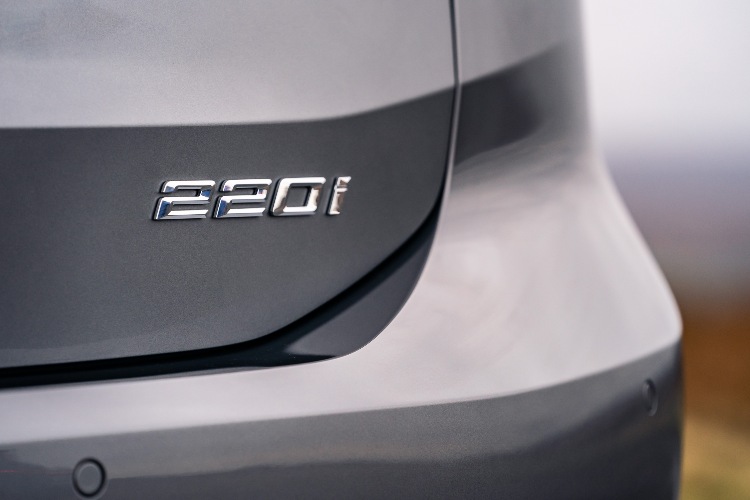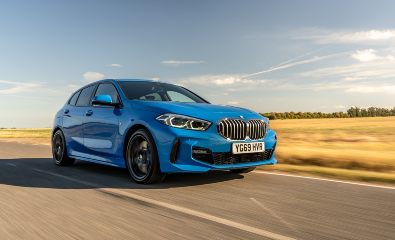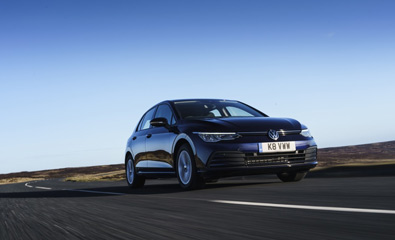What Is It?
This is the 2nd generation of BMW’s late-to-the-party mini-MPV, the 2 Series Active Tourer. Given the German outfit didn’t arrive in this particular automotive sector until 2014, by which time most people were already abandoning MPVs in favour of SUVs with multiple seating rows, it’s something of a surprise that BMW is continuing with the formula into the 2020s. However, the company sold 430,000 globally of the 1st-generation car (which was also offered as a longer, 7-seat Gran Tourer – the Active Tourer is a 5-seater model) and around 10% of those found homes in the UK, so it should continue to prove a popular model over here for the Bavarian firm.
The Active Tourer – no confirmation one way or the other for the larger Mk2 Gran Tourer variant just yet – therefore joins the current 2 Series family in the BMW stable, and what a varied family it is. You’ve got this car, a 2-box, upright MPV-hatch type thing. You’ve then got the seriously awkward-looking 2 Series Gran Coupe, a 4-door saloon that’s roughly analogous to a 3-box 1 Series more than anything, and then the racier 2 Series Coupe, inevitably to be joined by a Convertible spin-off before long.
The weird thing about this is that the Coupe and (yet-to-be-confirmed) Convertible sit on BMW’s larger CLAR chassis, which means they’re ostensibly rear-wheel drive and related to the 3 Series, 4 Series et al; the 2 Series Gran Coupe is on FKL2, an older front-drive platform for the 1 Series and MINI; and then this Active Tourer is on the FAAR platform that’s the basis for a new range of electrified small cars from the BMW Group.
Confusing, eh? Never mind. All you need to know is that the 2 Series Active Tourer is back for another round, and it has launched initially with a choice of a solitary 4-cylinder turbodiesel engine and 2 mild-hybrid-assisted (MHEV) petrol engines, 1 with 3 cylinders and the other with 4, while 2 plug-in hybrid electric variants (PHEVs) will join the range in summer 2022. Both the petrol MHEVs and the PHEVs use upgraded electrical hardware: the MHEVs are on the 2nd-generation of hybrid technology, while the PHEVs gain BMW’s 5th-generation eDrive kit – this bringing significant gains for power, performance and zero-emissions driving range.
However, we’ll come onto those other models in the driving section later on in this review. All you need to know for now is that we were handed the keys to a 220i Active Tourer Luxury (that’s the version with the 3-cylinder petrol MHEV drivetrain, in mid-grade trim spec) and sent toddling off into the Cotswolds to find out all about this unusual BMW.
What’s Good About It?
The interior is superb, although some will no doubt lament the passing of the rotary iDrive controller. Yes, the 2 Series Active Tourer sees the debut of BMW’s touch-and-voice-controlled OS8 infotainment software, which has only been seen in larger, grander cars like the iX and i4 electric vehicles (EVs) so far. This means the iDrive dial is gone and replaced by a raised, floating centre console on which you’ll find the engine start/stop button, a remarkably discreet toggle gear selector and some sundry other controls, including the hazard-warning switch.
No matter about the absence of iDrive; in front of you is the majestic BMW Curved Display. This features a 10.25-inch Information Display (read: instrument cluster) alongside a 10.7-inch Control Display (further read: infotainment screen). All of the information displayed on these 2 items is crystal clear and thoroughly configurable, so it’s a big technological improvement on the old car’s cabin, and there’s also a real ‘lounge’ ambience to the way BMW has dressed the rest of the interior. Furthermore, everything your hands come to rest on or operate feels of the highest quality possible, so the interior is off to a flying start in terms of early impressions.
What Could Be Better?
Discussing exterior styling is very subjective, and we’d accept that the smoother appearance of this 2nd-gen Active Tourer certainly beats that of its ungainly and beaky predecessor – even if BMW has put its favourite aesthetic-ruining detail of the moment, namely ginormous and distended kidney grilles, slap-bang into the face of this fresh MPV. Strangely, though, and perhaps because we’re getting used to this affront to our senses by now, these grilles don’t look too bad unless you happen to be dead in front of the 2 Series AT and crouching down to look at it; from most other angles, these gargantuan appendages seem to visually blend in OK.
Nevertheless, and accepting that BMW’s designers are working with a basic tall 2-box MPV shape (which was never going to be achingly pretty no matter what flourishes of their pens they came up with), the 2 Series Active Tourer is still no looker. Obviously, that’s a subjective viewpoint, but it’s just the way we see it. There are some extremely nice colours in the new paint palette, though, including Piemont Red, the luscious Sanremo [sic] Green and also Sparkling Copper Grey.
What’s It Like To Drive?
Rather brilliant, considering what it is. Honestly, although this car and its immediate predecessor were front-wheel-drive BMWs and therefore ‘utterly wrong’ in the eyes of diehard marque enthusiasts, they’re still creations of Munich. However, the Mk1 Active Tourer was sharp to drive in all situations, which meant it was fun in the corners but could be hampered by a somewhat brittle ride on poor road surfaces.
This generation of Active Tourer, though, has no such problems. It still has a lively chassis and, thankfully for a modern BMW, steering which is unaffected by artificial gloopiness and unpleasant weighting in its Sport mode. This means that you can stoke the 220i up into a decent clip and it feels fluid, fun and fairly fast as well. Honestly, there’s no need for a family MPV to be anything like as dynamically talented as this, because it can truly verge on being a giggle to drive if you’re on the right road and in a mischievous mood. Bear in mind it is related to a MINI, no matter how distantly, and you soon understand why the handling is as crisp as it is.
Where the major improvements come is in the ride and refinement. While you can still sometimes discern a touch too much detail about the road surface in the 220i Active Tourer Luxury (not even an M Sport, remember), in the main it covers up imperfections in the asphalt with genial good grace. Furthermore, with loads of sound-deadening around the passenger compartment and its highly aerodynamic design, you don’t hear an awful lot of wind noise while you’re travelling along – even at motorway speeds.
In terms of the drivetrain, this 220i already feels like a sweet spot. It’s a 1.5-litre turbocharged 3-cylinder with 156hp, augmented by the 19hp of MHEV tech for peak outputs of 170hp and 280Nm. That’s enough to see the front-drive, DCT-equipped 220i to 62mph from rest in 8.1 seconds, and it feels every bit as rapid as that last stat would have you believe. It also makes a great noise, the 3-cylinder trilling away up front as you rev it out, while the automatic transmission is an unobtrusive peach as well.
If you fancy something else other than 3-pot petrol power, the turbodiesel 218d musters up 150hp and 360Nm from its 2.0-litre engine, resulting in 0-62mph in 8.8 seconds, while the 223i is also a 2.0 4-cylinder motor (but petrol this time) with 218hp, 360Nm and a 7-second 0-62mph time.
Mind, the eye-opening cars are the 2 xDrive (AWD) PHEVs due in for summer ’22. Both use the same 1.5-litre 3-cylinder engine as the 220i, only augmented with electric motors and 14.2kWh battery packs. For the 225e xDrive, you get 136hp from the internal-combustion engine (ICE) and 109hp from the e-motor, for a combined output of 245hp and a 223i-equalling 0-62mph time of 7 seconds. Enough, you might think, for any small family MPV to be getting on with… except there’s then a bonkers 230e xDrive, which teams a 150hp ICE with a whopping 176hp e-motor (that’s twice the output of the old 225xe Active Tourer PHEV’s e-motor, with its ‘meagre’ 88hp!) for a combined 326hp and a 5.5-second 0-62mph run. Although why you’d need 326hp to take the kids on the school run in the morning is anyone’s guess…
How Practical Is It?
BMW has done excellent work here to make the 2 Series Active Tourer as useful as it can be to its primary target audience – families. So every model comes with 40/20/40 split-folding rear seat-backs, as well as the ability to tilt and slide the 3 individual chairs back there to increase boot space by up to 90 litres. It’s also really comfortable to be sitting in either row 1 or 2 of the 2 Series Active Tourer, although we will say the driving position does feel quite lofty and ‘perched’ compared to BMW’s other models. And that’s allowing for the fact this is a high-set MPV in the first place.
Talking of boot space, there’s the usual PHEV sacrifice of cargo capacity, although it’s not as bad as you might think. Due to the placement of the 225e and 230e xDrive models’ battery pack this time around – it’s flat in the floor, instead of located under the back seats – the Active Tourer PHEVs have 406 litres of boot space as a minimum and up to 1370 litres if you fold the rear row of chairs away. That compares to 415-1405 litres for the 220i/223i petrol-MHEV cars, which in turn aren’t quite as good as the 218d (470-1455 litres) because various bits of their hybrid gear are under the boot floor.
Anyway, stowage up front is good, with cupholders behind the angled wireless smartphone charging pad (if so equipped), big door pockets on show and a lower-level tray for paraphernalia beneath the main floating armrest. It’s also practical in the back for people sitting in row 2, so as a flexible MPV interior it’s right up there with some of the best available to lease today.
How Much Will It Cost Me?
BMW UK will sell the 2 Series Active Tourer in 3 specifications, starting with a Sport and rising through Luxury to top-grade M Sport. However, all 2 ATs are generously equipped, as a Sport comes with 17-inch star-spoke alloy wheels, Sports seats in cloth upholstery, High-Gloss Black exterior detailing and roof rails, LED headlights, an automatic tailgate, Extended Lighting in the cabin, the BMW Curved Display infotainment system, cruise control, dual-zone climate control, Parking Assistant (comprising a reversing camera, as well as PDC parking sensors front and rear), and a dual-clutch automatic transmission as standard, among more.
Luxury models upgrade the alloys to bicolour V-spoke 17s, while adding heated front seats and Vernasca leather upholstery inside, as well as fine-wood interior trim and Aluminium Satinated exterior bits where there’s High-Gloss Black on the Sport. Finally, M Sport has the usual slightly more aggressive exterior styling plus larger 18-inch M bicolour alloys, Alcantara and Sensatec upholstery, the Extended Mirrors Pack, Adaptive LED headlights, Comfort Access, wireless smartphone charging, Adaptive M Sport suspension, a DCT Sport auto transmission (this brings in paddle shifts on the wheel) and something called a ‘luxury finish’ instrument panel. Although surely the Luxury model has a luxury-finish instrument panel…?
But we digress. As to economy, the launch models offer 53.3-58.9mpg with 125-138g/km of CO2 (218d), 43.4-47.9mpg with 133-148g/km (220i) and 42.8-47mpg with 137-149g/km (223i) running costs, although you might want to hang on for the PHEV models (225e xDrive and 230e xDrive) in summer 2022 – as their CO2 outputs are in the region of 22-30g/km, they can go up to 56 miles on electric power alone, and they’ll likely have official quoted economy figures well in excess of 100mpg as a result. Not that you’ll ever achieve such lofty consumption goals, of course, but the emissions remain valid for taxation purposes.
In terms of list prices, the 220i Sport is the cheapest model at £30,265, but our test Luxury model with a few options was nudging 40 grand. Realistically, the 2 Active Tourer PHEVs are going to be that sort of money in basic specification, so it’s not the cheapest small MPV you can buy right now. That said, Vanarama leasing rates promise to be highly competitive, so if you fancy the look of this BMW family chariot, keep an eye on our deals in the coming months for the refreshed 2 Series Active Tourer.
Anything Else I Should Know?
Despite its rather bluff shape, the BMW 2 Series Active Tourer is a seriously aerodynamic vehicle. It is fitted with all kinds of measures to channel airflow as neatly as possible around its bulky form, as well as having some active aerodynamic features (moving air flaps in the kidney grilles being 1 of them) and a completely sealed underbody, so that it can record a coefficient of drag (Cd) figure of just 0.26 in the right spec. As a historical point of reference, the slippery-looking Vauxhall Calibra of 1989 was the car with the lowest aerodynamic figure of all with… yep, 0.26Cd. Which was considered enough of a feat back then to be a unique selling point of the Calibra, although you needed an absolutely bog-basic version for it to cut through the air best – Turbo and 4x4 models were out at 0.29Cd. Tsk. Anyway, here we are now in 2022, and somewhat incredibly an upright MPV can match that headline-grabbing Cd figure of a sports coupe from yesteryear.
What Alternatives Should I Look At?
Citroen Berlingo Leasing
More prosaic MPV motoring than the BMW but the Berlingo is great value.
Mercedes B-Class Leasing
The most obvious direct rival for the 2 AT, Merc’s B-Class isn’t anything like as much fun to drive.
Volkswagen Touran Leasing
Offered in 5- and 7-seat formats and does a good job, albeit the VW is rather dull.
The Verdict: 8/10
"BMW has done excellent work here to make the 2 Series Active Tourer as useful as it can be to its primary target audience – families."
Three Things To Remember About The BMW 2 Series Active Tourer:
-
Sits on a development of the 1 Series and MINI chassis; so not RWD
-
2 PHEV models are inbound, one with 326hp!
-
Very practical and classy, but not exactly cheap
For more articles, you can check out our car features and guides section. Or if you're looking for a brand new vehicle, we've got a huge range of cars to lease at unbeatable prices.

